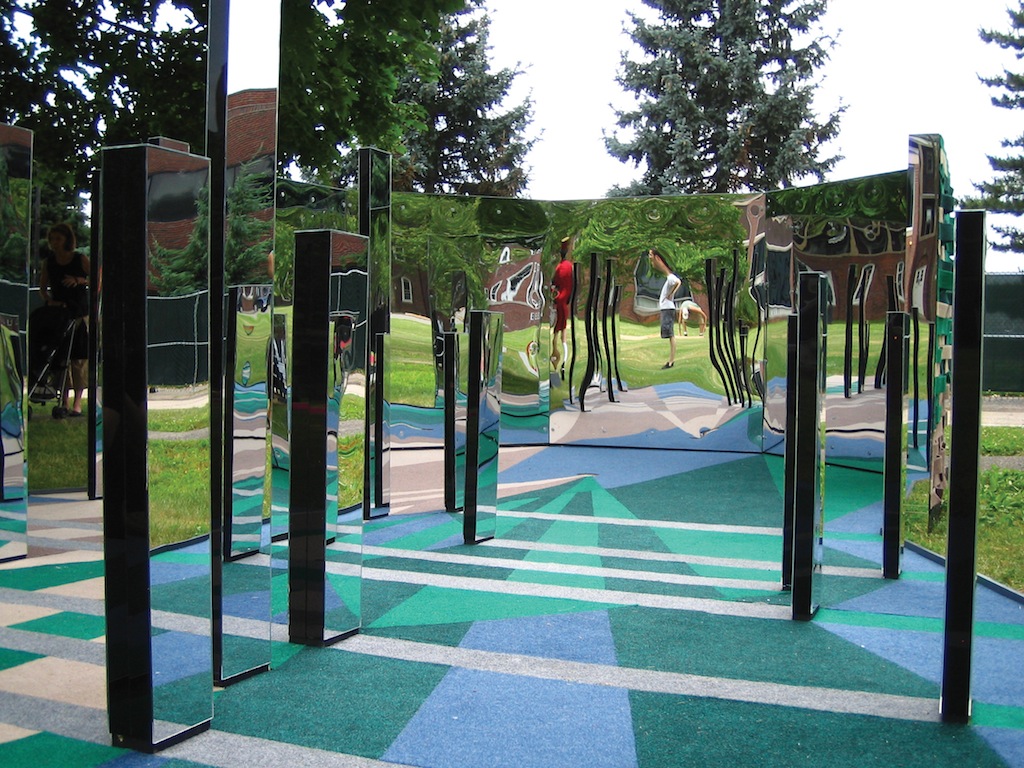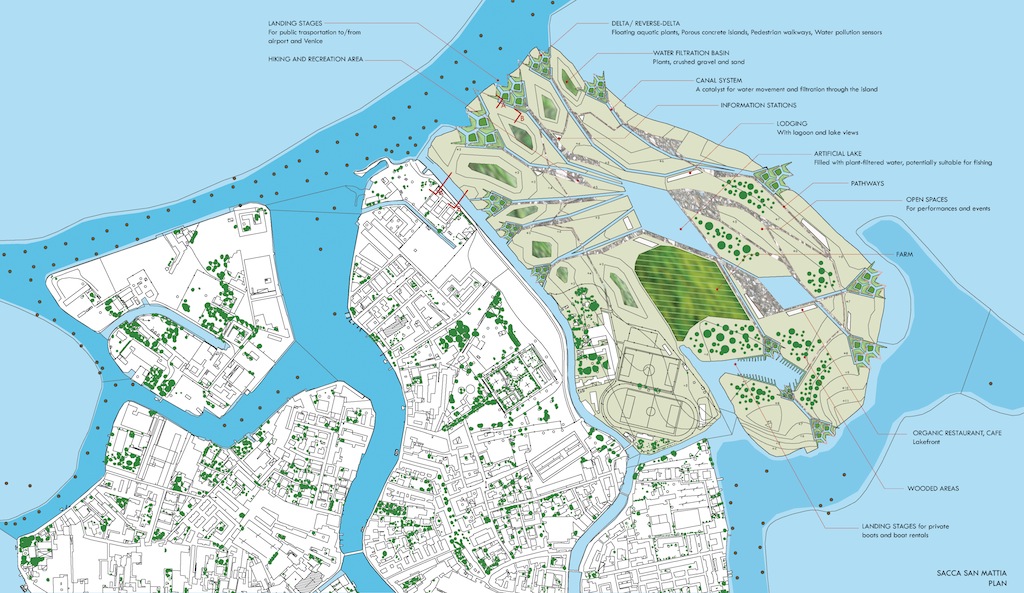Interview: Ants of the Prairie
Emerging Voices 2014
Ants of the Prairie
Joyce Hwang
Joyce Hwang founded her Buffalo-based firm Ants of the Prairie in 2004 as an architecture and research practice “dedicated to developing creative approaches in confronting the pleasures and horrors of our contemporary ecologies.” Recent and ongoing projects such as Bat Tower (Ashford Hollow, New York), Bat Cloud (Tifft Nature Preserve, Buffalo, New York)—each in collaboration with biologist Katharina Dittmar and structural engineer Mark Bajorek—and bird and bat Habitat Wall realize her firm’s goal to “consider challenges posed by ecological conditions today, not as limitations, but rather as instigators for innovative practice.” In March 2014, on the occasion of her Emerging Voices lecture (video embedded below, also available here), Hwang sat down with League Program Director Anne Rieselbach and Program Associate Jessica Liss to discuss her practice.
Jessica Liss: This series emphasizes the voice of practitioners. How do you describe your voice?
Joyce Hwang: I think of myself as an advocate for thinking about cross-species design: how can architecture go beyond the anthropocentric view of the world? Animals are the intended users or inhabitants of my projects.
I’m also interested in the gaps of logic in sustainability. If you’re considering sustainable practice nowadays, you often think of green building technologies, solar panels, energy efficiency. I’ve been thinking about the ecological conditions that already exist and how we can capitalize on them, not just as regulations but as potential spatial conditions.

Bat Tower, Griffis Sculpture Park, East Otto, NY | Photo by Joyce Hwang
Liss: As an emerging firm, what do you see as the advantages and challenges of practicing in today’s economic, professional, and intellectual climate?
Hwang: It’s difficult for young architects to get commissions today. Prior to starting my own practice, I worked in a number of firms for five years and learned that a lot of what clients are looking for is former experience and, to a certain degree, predictability. If you are interested in doing work that doesn’t fit within an established way of doing things, you’re less likely to get a commission. It’s also difficult economically for people who don’t have access to money to start building. You can’t always get a commission doing a house for your parents. In order to practice architecture as a means of advocacy, instead of strictly as a service, one has to find other means of getting funds, namely grants or partnerships through other organizations.
Liss: And so many of your projects are self-generated. Where do you look for inspiration and how do you find the means to carry out these projects?
Hwang: Right—there aren’t any RFPs for animal projects. I actually think of projects like a thesis. When you start a project, you always begin with research and a set of questions, and from there something starts brewing. I don’t find the idea of self-generation to be a novel thing—it happens all the time in academia. I find inspiration in simply looking around at things in the world.
In terms of carrying out my ideas, it helps that I’m working in a university and that a huge amount of my salary comes from teaching. I have the luxury of working on something by myself before involving anyone else. Once I’m able to find grants, organizations, or partners that are willing to support the project, I can start hiring people or buying materials. The initial funding for Bat Tower was through a NYSCA Independent Projects grant.

Trees cocooned in spiders webs after flooding in Sindh, Pakistan | Photo via Russell Watkins/Department for International Development
Liss: You describe Ants of the Prairie as a practice committed to developing ways to tackle the “pleasures” and “horrors” of today’s ecological conditions. Can you elaborate on exactly what you identify as these pleasures and horrors?
Hwang: I think that pleasures and horrors evoke much more of an experience than, say, problem solving. If I say I’m trying to address environmental problems, it suggests that I approach ecological conditions as problems to solve. I’m interested in how you can think about a condition as a potential experience, either a very pleasurable one or one that evokes horrors that we might intrinsically feel towards that condition.
For example, there’s a huge amount of fear of bats, and of animals in general, especially when an encounter occurs with undomesticated animals in places where we don’t expect them. There’s an intrinsic sense of horror that we feel, and I think that’s something to address, not ignore. But there can be a flip side. Natural disasters are horrific experiences, but, as an example, after the recent flood in Pakistan, spiders climbed into the trees and created webs that were actually quite stunning. These ecological conditions are not just issues or problems but also potential experiences.

Bat Cloud, Tifft Nature Preserve, Buffalo, NY | Photo by Sze Wan Li
Liss: Your work is, in part, a response to habitat loss for animals in cities, and both Bat Tower and Bat Cloud are located in Buffalo. Are these models designed to be scalable? How do you see them functioning in a higher density place such as New York City?
Hwang: Bat Cloud could be scalable through increasing the number of modules in a cluster, and that’s something we’re working on now. The one we designed for Buffalo is composed of 22 modules. We’re designing a version for Rotterdam that has six. Bat Tower is much more of a stand-alone installation. But Pest Wall and Habitat Wall came out of the thinking behind Bat Tower—by scaling and unfolding it, by looking at how the ideas in the tower could be implemented along a surface, which might fit better into the context of a denser environment.
Liss: You use both low-tech and high-tech methods in your projects. How do you decide on those tools, and what do you see as their effect?
Hwang: In developing Bat Tower, the uniqueness of the form naturally gravitated towards CNC milling as a technique. I also think there was an affinity to the way that I model—in which I use laser cutting all the time—that translated very naturally into the making of the piece, which had over 400 wooden pieces. When I shifted to Habitat Wall, I didn’t want to use CNC fabrication, because it made up about half the cost of Bat Tower and we had much less money for the project. I can use standard tools in the shop quite well, so I designed the wall to be all straight cuts. We were also using recycled materials from Buffalo Reuse; to me, that suggested that we use more traditional ways of working with material.
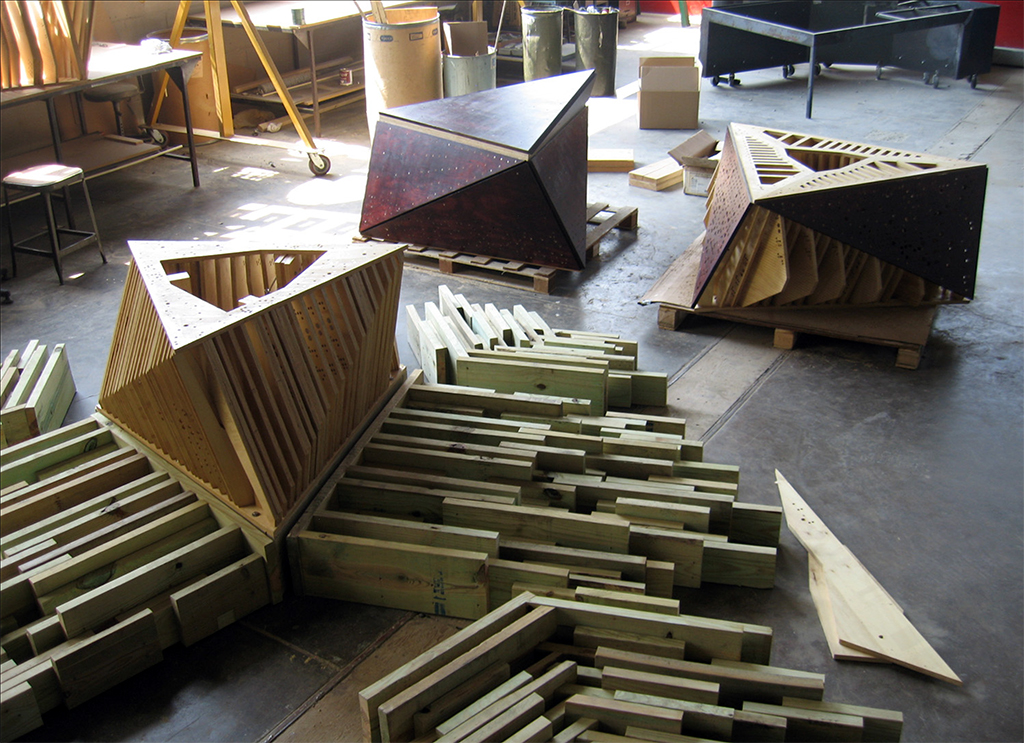
Bat Tower in fabrication | Photo courtesy of Ants of the Prairie
Anne Rieselbach: Are those wall plans something that you would consider releasing as an open source document so that it could be replicated by other people?
Hwang: I’ve received many emails asking if I could send out my plans. I think about this a lot: would anybody ask me to send them plans for a house so they could build the exact same thing? At the same time I think, why not? It’s important for people to be interested in creating environments that are suitable for habitat. But it would be difficult to put out a set of documents that would actually be complete, because our process is very back and forth between drawing and making. We’ve actually had to play catch-up many times when a publication asks for drawings and we have to redo them based on changes made while we were making.
Liss: You collaborate with many people across disciplines. What is that collaboration process like with a project like Habitat Wall?
Hwang: That project has traversed many different phases. It started when I was speculating on making a wall for bats and birds called Pest Wall. At the time I was basically sitting there by myself making little models and renderings. I was also talking with Katharina Dittmar, the biologist I worked with on Bat Tower, to get feedback. I had a little bit of money left over from another project, so I hired a few students to develop the ideas. Then I received the MacDowell Fellowship, which is an artist residency at the MacDowell Colony in Petersburg, New Hampshire. It’s the oldest residency in the United States, and they accept artists from a whole host of different disciplines—fiction writers, playwrights, poets, sculptors, painters, architects, et cetera—who choose to stay somewhere between two to eight weeks. It’s an incredibly productive time because you’re secluded from the world, and you get to have these short, intense, inspiring exchanges with other artists.
When I received the fellowship and it went out on the local news, the executive director of the Buffalo Audubon Society contacted me and asked me if I would consider building one of the walls for the Society. I visited their center to look around at different structures and sheds that the wall might attach to, so when I went to the MacDowell Colony I already had a site in mind. I began working through various models by myself, but I credit many of the artists at MacDowell for being critics and advisors during that process. Sculptors critiqued the form, and writers asked me why I had called it Pest Wall, given that “pest” is such a pejorative word. So it turned into Habitat Wall. The project was quite well developed when I left.
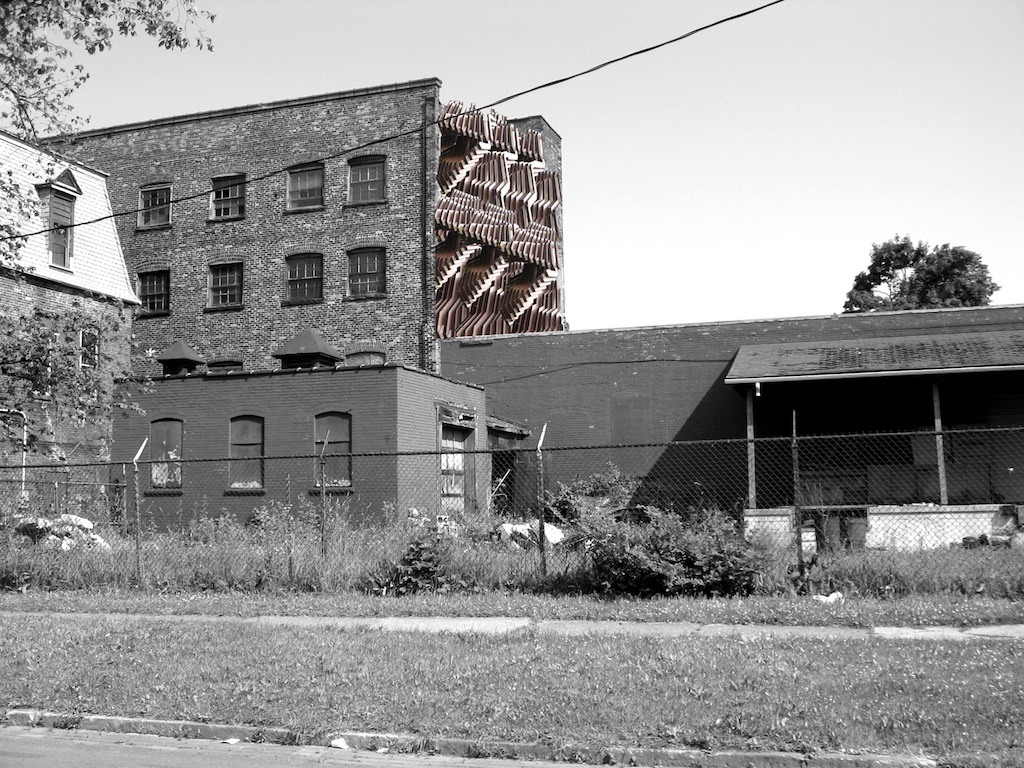
Pest Wall, a proposal to incorporate urban wildlife habitat conditions in a building facade | Rendering by Joyce Hwang
Meanwhile I was still working in collaboration with Katharina, the biologist, and she made suggestions for making different cavities within the roof spaces that led to further adjustments as I developed more detailed designs and construction documents.
When the summer started, I hired a number of students to work with me in the shop in Buffalo to start constructing pieces. The project is on the back burner for the moment because of a deadline for the International Architecture Biennial in Rotterdam, but we have plans to install, and it’s been great to have the support of the Audubon Society and the university throughout the process.
Liss: You’ve suggested that ornamentation on buildings can be used as animal habitats. How do other architects react to that?
Hwang: This is actually somewhat of a new proposition. I wrote an article called “Living Among Pests” in Volume magazine, which was the first time I suggested that in a public way. The reaction has been mixed: some say, “Wow! That’s interesting.” But there are some architects who say there’s no way they can see that happening.
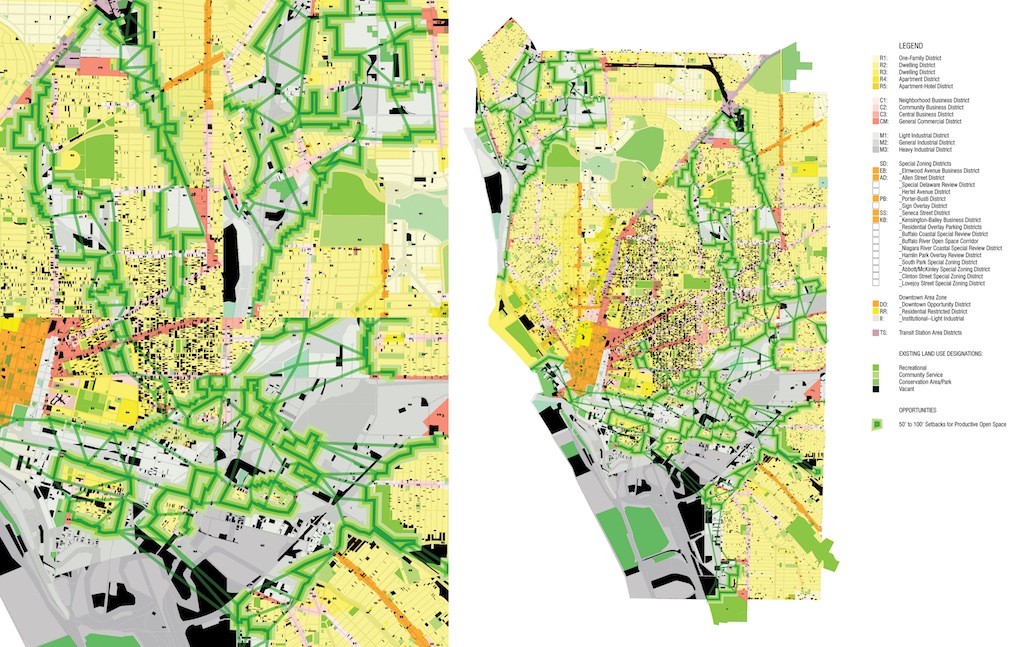
Generative Zoning is a research project to reveal spatial and ecological opportunities within current zoning ordinances in Buffalo, NY | Drawing by Joyce Hwang
Liss: Tell us more about your design schemes for crop enclosures and how they function as tools for urban farming.
Hwang: Those really came about when I was looking for a site for Bat Tower in Buffalo. Some of the groups I approached were local urban farming organizations. One organization on the west side of the city was very interested, but they had a concern that if anything well designed appeared on their site, it would probably be vandalized and ruined. They explained that one of their biggest issues is the tension between wanting to keep the farm open for the people in that neighborhood to get vegetables to eat and feeling dismayed by the number of times people would just throw the vegetables all over the street, totally wasting what they had worked so hard to produce. So I began thinking about how you can enclose crops in a way that isn’t just putting a fence around them, something that still lets in sunlight and water and allows people to engage with the food while also protecting it.
I thought that it would be made of stainless steel wire mesh, and the form came from sectional studies of what kind of dimensions you would need to crouch down and pick up something, those dimensions of the human body. I was also interested in using the enclosures like furniture pieces, so that you could potentially sit down instead of standing around for a really long time, which might help the garden become more of a community space. And these low, horizontal pieces would also define walkways throughout the site. The project hasn’t really progressed beyond an initial, conceptual stage.

Bat Tower interior, looking down from inhabitation zone | Photo by Albert Chao
Liss: How do you measure the success of your projects?
Hwang: You can of course measure their success by noting whether or not animals actually inhabit them, but also by testing the internal temperature and humidity of a piece to see if it actually mimics conditions in nature. Katharina and I are working on the way using certain materials together can replicate the environments animals need. That, of course, doesn’t depend only on the piece itself; it also depends on where it’s sited and a whole host of other factors.
It’s also very important that my projects are not seen as architecture only for animals. Ultimately they’re there for people to enjoy, and to make an impact on human perception—whether or not people like them is important to me as well.
Liss: What else have you been thinking about? What’s next?
Hwang: I’m interested in rethinking the idea of adaptive reuse. With so many vacant buildings in Buffalo, I really like the idea of transforming an existing building into something that could be half habitat. But I haven’t started acting on this yet—it’s more of a hope for the near future.
•••
Joyce Hwang, Ants of the Prairie, Emerging Voices 2014, complete lecture video | Recorded March 13, 2014 | Running time: 39:09
•••
Joyce Hwang received her B.Arch from Cornell University and M.Arch. from Princeton University. She currently teaches at the University of Buffalo, State University of New York, where she is an Associate Professor and Director of Professional Studies, Department of Architecture. She was the winner of the Urban Animal, Animal Architecture Awards, and has received fellowships from the New York State Foundation for the Arts and the MacDowell Colony, as well as Independent Project grants from the New York State Council on the Arts.


